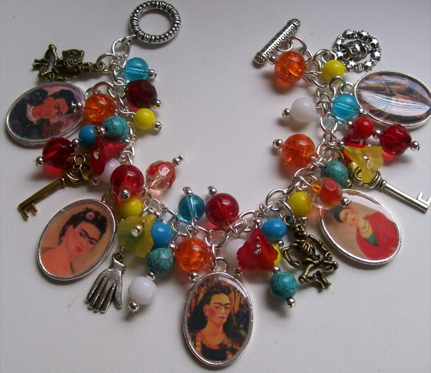Tube paints provide the freedom to paint out-of-doors, formerly, painters mixed pigment in their studios. This no fuss no muss ability is revolutionary to the world of painting; it is the catalyst announcing Modern Art, and the Passing of the Renaissance era. A distinctive style and a new technique of painting is born. Beginning with Monet, successive paintings, in this collection, illustrate change and the differences between Modern and Renaissance painters. The London based, Winsor-Newton Company invented and manufacture tube paints. This image is of their first tube paints, 1840 - 1911.
Frida Kahlo (1907 - 1954) In 1925, Frida is riding in a bus that tragically collides with a trolley and her future is altered instantly. Multiple back injuries and a crushed pelvis, made worse by a limp left from childhood Polio, require lengthy convalescence and a future seriously affected by the accident.
Destiny prevails when Kahlo first meets Diego Rivera. He is a 37-year-old accomplished painter. She is a fifteen-year-old student. Rivera is making his first significant mural at Kahlo’s school. Despite Frida’s and Diego’s two, tumultuous marriages, Rivera is her mentor and supporter. This is a photo of the couple.
Kahlo’s friend, Surrealist writer, André Breton arranges her first solo exhibition, in 1938, at a gallery in New York City. The following year Breton suggests a show in Paris. Reviews are good, the Louvre buys a painting making her the first Mexican artist featured in their collection, and Picasso offers praise.
Circumstances lead Frida on an unexpected path when she is appointed Professor of Art at Mexico’s National School of Painting, Graphics, and Sculpture, in her mid-thirties.
Time passes and Kahlo returns to America and her home in Mexico to exhibit and teach until she passes.

Modern, Surrealist movement (1920s – 1930s) André Breton, poet and critic is the major spokesperson for Surrealism. He describes the movement as a positive expression to create a “super-reality.”
The new revolutionary philosophy of Communism begins in Paris and draws some artists into and others out of the movement.
Breton and his friends leave their homeland for the United States and Mexico during the War between Germany and France and they stay until it is safe to return. The group make a side trip from America to visit Kahlo and Rivera. All of them are staunch supporters of the political ideology.
Russian revolutionary leader Leon Trotsky, shown seated, is invited to this gathering, before he is gruesomely assassinated with an icepick in a suburban villa outside of Mexico City.

Go on to Describe, Analyze, Interpret & Conclude. Contact me for help.
The Two Fridas 1939. Oil on canvas. 67 x 67 in. (174 x 173 cm.) offer an unusual opportunity to see the same person depicted wearing different dresses in an intense, autobiographical double-portrait.
The symbolism of her naïve, primitive style packs a wallop. Zoom and roll over Frida’s figure to read its meaning, courtesy of PBS. Notice Frida graphically expresses her emotions leaving little to question.
Kahlo is one of the most famous modern artists of Central America. She speaks out about the surrealist artists she knew in Paris. “They accept Sigmund Freud, the psychiatrist, whose work is clinically based on the fusion of the conscious and subconscious life.”
“They thought I was a surrealist, but I wasn’t. I never painted my dreams, I painted my own reality.” Some Art historians see her work as connecting the concerns of popular art intended to be appreciated by ordinary people and those of modernist avant-garde painters.
From a broader, contemporary perspective, The Two Fridas appear to blend the schools of realism, surrealism, and symbolism, as well as folk, and feminist art.